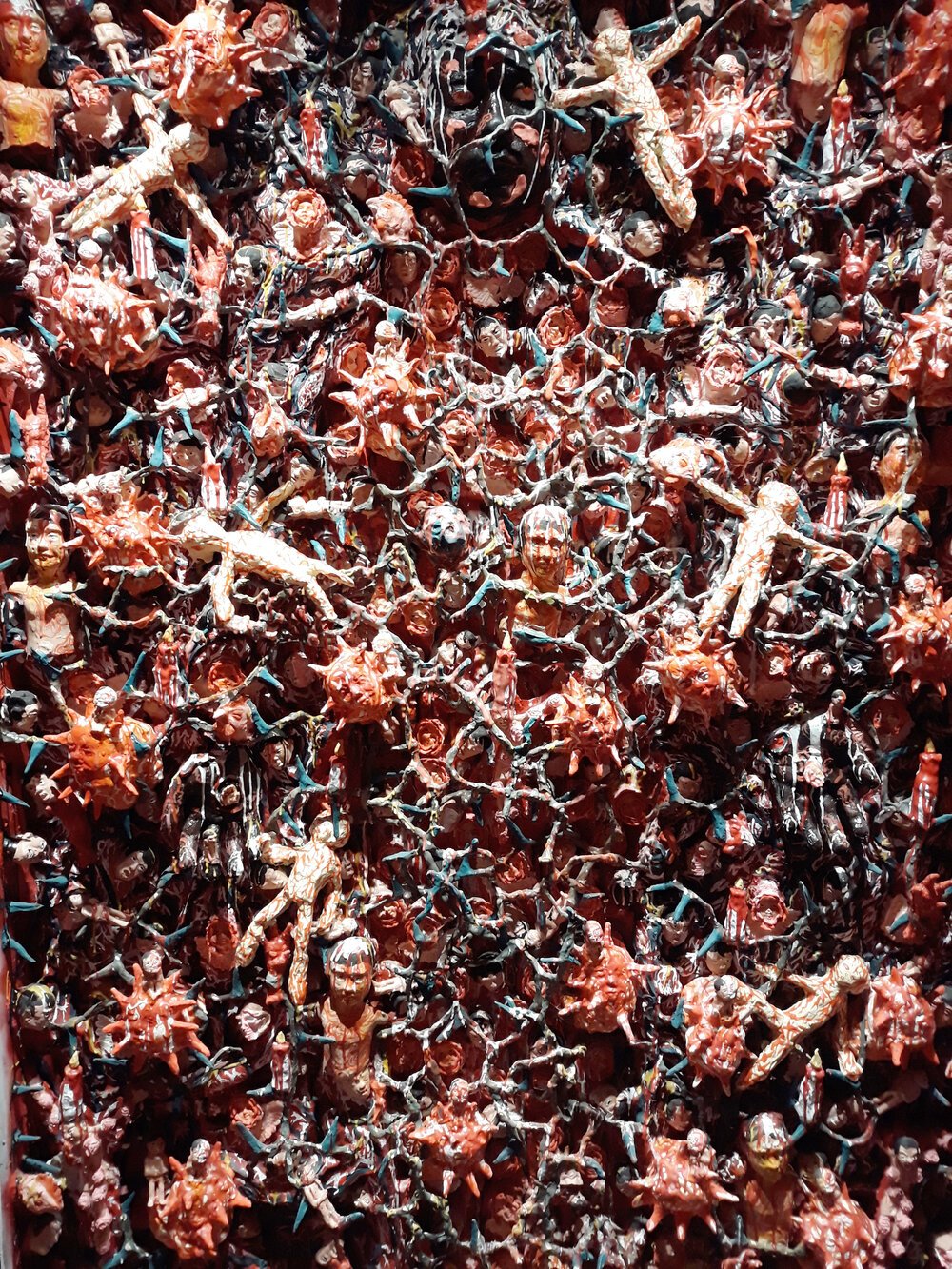Doktor Karayom
Creating the macabre as catharsis
By Alana Malika
Doktor Karayom, ‘KARAYOMDUGYOTFACE’, 2021, acrylic paint, resin and epoxy on canvas, 182 x 122 cm. Image courtesy of the artist.
Filipino artist Russel Trinidad, publicly known by his moniker Doktor Karayom, is distinctly known for his artistic fixation on the colour red and the human anatomy. His art treads the line between fascination and disgust by distorting, disfiguring, and dismembering the physical body. Trinidad’s almost exclusive use of red captures the visceral nature of his work while compelling the audience to look closely into the social commentaries at play.
Doktor Karayom working in his studio space. Image courtesy of the artist.
Trinidad dove into the local art scene in the Philippines as a graffiti artist painting murals on abandoned buildings. As a Fine Arts student at the Technological University of the Philippines, he hid behind his street name ‘Doktor Karayom’ to avoid vandalism charges. After graduating, the artist worked as a graphic designer for a company based in Makati. It was at his office where he began doodling with a red ballpen. Outside of his corporate job, Trinidad restlessly developed his practice and gory art style. The artist continued his street art practice while holding solo exhibitions and fulfilling commissions for his red paintings and sculptures. Doktor Karayom started to garner local attention, receiving mainstream media coverage for his street art. He found success in art competitions, first winning a t-shirt design contest for a local fashion brand, and later the Ateneo Art Award in 2017 then the Thirteen Artist Award in 2018.
Installation view of ‘Isla Inip’ (2018). Image courtesy of the artist.
‘Isla Inip’ (2018), an anagram for Pilipinas, earned Trinidad the prestigious Thirteen Artists Award by the Cultural Center of the Philippines at 27 years old as the youngest awardee in his cohort. The installation features an interactive board game that immerses viewers into a maze of Jose Rizal’s entrails. At the center lies the national hero’s 13-foot corpse, his flesh populated by tiny people. Trinidad’s crimson floor-to-ceiling illustrations and sculpture confront viewers with a harrowing truth about the nation’s collective psyche. The tiny figurines seem to be in a state of ‘inip’ or boredom, oddly unfazed by the rotting cadaver. The piece speaks to the farces and propagandistic narratives people believe to distract themselves from the grim realities of daily life in the Philippines, or in this case an ‘isla’ of martyrdom.
Doktor Karayom, ‘Ang Paghiga sa Tinik ay Pagpatubo ng Bulaklak’, 2021, 182.88 x 121.92 x 12.7 cm, wood, resin, fiberglass and spray paint. Image courtesy of the artist.
Doktor Karayom has had a consistent lineup of exhibitions since his first solo show ‘Santong Pikon!’ (2015), including ‘Habak’ (2020) at Artinformal Gallery. Habak is a reference to a Visayan amulet passed down from ancient Philippine warriors who wore them for invincibility at war. In the Philippines today, elderly mystics wear habak around their hips to fend off evil. Trinidad’s exhibition makes these waging invisible wars of spirit versus amulet tangible on canvases festering with resin sculptures of eyes, faces, and bloody figures catching fire. However, the artist does not intend for these depictions to strike fear, but to give strength and protection to all who see his work.
Ultimately, Doktor Karayom’s use of the macabre funnels the all of the inner physical, emotional, and spiritual turmoil we face into outward pain. This gory bacchanalia depicting wounded and mangled bodies evokes strong reactions from the audience as an cathartic release.

















